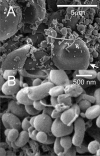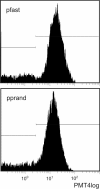Post-prandial rise of microvesicles in peripheral blood of healthy human donors
- PMID: 21418650
- PMCID: PMC3071324
- DOI: 10.1186/1476-511X-10-47
Post-prandial rise of microvesicles in peripheral blood of healthy human donors
Abstract
Background: Microvesicles isolated from body fluids are membrane - enclosed fragments of cell interior which carry information on the status of the organism. It is yet unclear how metabolism affects the number and composition of microvesicles in isolates from the peripheral blood.
Aim: To study the post - prandial effect on microvesicles in isolates from the peripheral blood of 21 healthy donors, in relation to blood cholesterol and blood glucose concentrations.
Results: The average number of microvesicles in the isolates increased 5 hours post - prandially by 52%; the increase was statistically significant (p = 0.01) with the power P = 0.68, while the average total blood cholesterol concentration, average low density lipoprotein cholesterol concentration (LDL-C) and average high density lipoprotein cholesterol concentration (HDL-C) all remained within 2% of their fasting values. We found an 11% increase in triglycerides (p = 0.12) and a 6% decrease in blood glucose (p < 0.01, P = 0.74). The post - prandial number of microvesicles negatively correlated with the post - fasting total cholesterol concentration (r = - 0.46, p = 0.035) while the difference in the number of microvesicles in the isolates between post - prandial and post - fasting states negatively correlated with the respective difference in blood glucose concentration (r = - 0.39, p = 0.05).
Conclusions: In a population of healthy human subjects the number of microvesicles in isolates from peripheral blood increased in the post - prandial state. The increase in the number of microvesicles was affected by the fasting concentration of cholesterol and correlated with the decrease in blood glucose.
Figures



Similar articles
-
Impact of metformin versus the prandial insulin secretagogue, repaglinide, on fasting and postprandial glucose and lipid responses in non-obese patients with type 2 diabetes.Eur J Endocrinol. 2008 Jan;158(1):35-46. doi: 10.1530/EJE-07-0500. Eur J Endocrinol. 2008. PMID: 18166815 Clinical Trial.
-
Effects of short-term modest weight loss on fasting and post-prandial lipoprotein sub-fractions in type 2 diabetes mellitus patients.Diabetes Metab. 2001 Dec;27(6):701-8. Diabetes Metab. 2001. PMID: 11852380
-
Extra virgin olive oil improves post-prandial glycemic and lipid profile in patients with impaired fasting glucose.Clin Nutr. 2017 Jun;36(3):782-787. doi: 10.1016/j.clnu.2016.05.016. Epub 2016 May 28. Clin Nutr. 2017. PMID: 27289163 Clinical Trial.
-
Lipoprotein(a) in alcohol-dependent male patients during a six-month abstinence period.Alcohol Alcohol. 2003 Mar-Apr;38(2):157-62. doi: 10.1093/alcalc/agg045. Alcohol Alcohol. 2003. PMID: 12634264
-
Metabolic heterogeneity underlying postprandial lipemia among men with low fasting high density lipoprotein cholesterol concentrations.J Clin Endocrinol Metab. 2000 Dec;85(12):4575-82. doi: 10.1210/jcem.85.12.7037. J Clin Endocrinol Metab. 2000. PMID: 11134111 Clinical Trial.
Cited by
-
Nanoparticles isolated from blood: a reflection of vesiculability of blood cells during the isolation process.Int J Nanomedicine. 2011;6:2737-48. doi: 10.2147/IJN.S24537. Epub 2011 Nov 8. Int J Nanomedicine. 2011. PMID: 22128248 Free PMC article.
-
Postprandial Increase in Blood Plasma Levels of Tissue Factor-Bearing (and Other) Microvesicles Measured by Flow Cytometry: Fact or Artifact?TH Open. 2018 Apr 16;2(2):e147-e157. doi: 10.1055/s-0038-1642021. eCollection 2018 Apr. TH Open. 2018. PMID: 31249938 Free PMC article.
-
Proteomic analysis of plasma-derived extracellular vesicles: pre- and postprandial comparisons.Sci Rep. 2024 Oct 3;14(1):23032. doi: 10.1038/s41598-024-74228-4. Sci Rep. 2024. PMID: 39363010 Free PMC article.
-
Endothelial microparticles (EMP) for the assessment of endothelial function: an in vitro and in vivo study on possible interference of plasma lipids.PLoS One. 2012;7(2):e31496. doi: 10.1371/journal.pone.0031496. Epub 2012 Feb 16. PLoS One. 2012. PMID: 22359595 Free PMC article.
-
Interplay Between Exosomes, microRNAs and Toll-Like Receptors in Brain Disorders.Mol Neurobiol. 2016 Apr;53(3):2016-2028. doi: 10.1007/s12035-015-9142-1. Epub 2015 Apr 11. Mol Neurobiol. 2016. PMID: 25862375 Review.
References
-
- Hägerstrand H, Isomaa B. Vesiculation induced by amphiphiles in erythrocytes. Biochim Biophys Acta. 1989;982:179–186. - PubMed
-
- George JN, Pickett EB, Saucerman S, McEver RP, Kunicki TJ, Kieffer N, Newman PJ. Platelet surface glycoproteins studies on resting and activated platelets and platelet membrane microparticles in normal subjects, and observations in patients during adult respiratory distress syndrome and cardiac surgery. J Clin Invest. 1986;78:340–348. doi: 10.1172/JCI112582. - DOI - PMC - PubMed
-
- Mrvar-Brečko A, Šuštar V, Janša V, Štukelj R, Janša R, Mujagić E, Kruljc P, Iglič A, Hägerstrand H, Kralj-Iglič V. Isolated microvesicles from peripheral blood and body fluids as observed by scanning electron microscope. Blood Cells Mol Dis. 2010;44:307–312. - PubMed
MeSH terms
Substances
LinkOut - more resources
Full Text Sources
Medical

